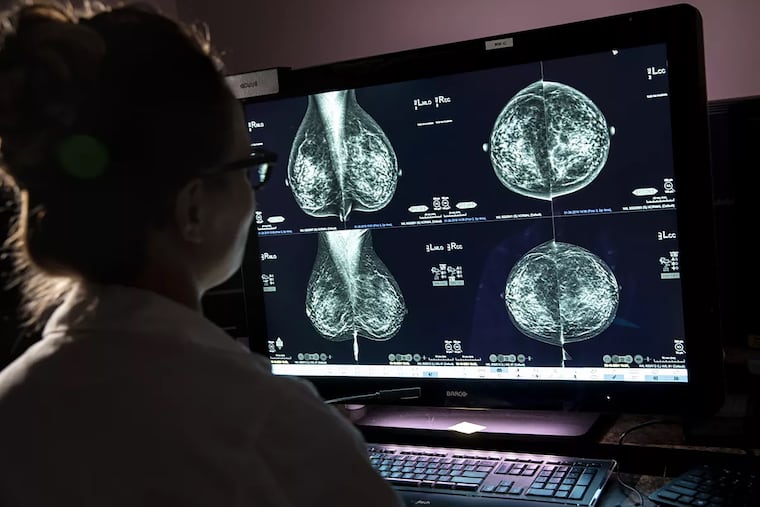What to know about breast cancer screening recommendations | Five questions with Penn’s chief of breast surgery
New guidelines are a starting point for more equitable breast cancer care, Penn’s chief of breast surgery says.

Oluwadamilola Fayanju was pleased when a national task force earlier this year took the first step toward recommending that women begin routine breast cancer screening at age 40, instead of age 50.
The chief of breast surgery at Penn Medicine’s Abramson Cancer Center has extensively studied race disparities in breast cancer, and believes that screening earlier will help detect aggressive cancers sooner in thousands of women.
But the updated guidelines, if adopted, would be just a start, she said in a recent interview with The Inquirer.
Women need more information about how to identify if they’re high-risk for cancer, and what to do if they are.
And there are still significant disparities in who participates in clinical trials.
Here’s what to know:
What should women know about the updated breast cancer screening guidelines?
A draft recommendation issued in May by the U.S. Preventive Services Task Force says women of average risk should begin biennial breast cancer screening at age 40, rather than 50.
About 9% of breast cancer cases are among women younger than 45 years old, according to the Centers for Disease Control and Prevention, but research has found a slow rise in the number of young women being diagnosed.
» READ MORE: We want to hear your thoughts about this and other health-related articles. Please fill out our Eds and Meds survey.
Fayanju emphasized that the recommendation is for people of average risk.
“What a lot of women don’t know is that they’re higher risk,” she said.
Fayanju suggests women begin talking to their doctor about breast cancer in their 20s. That may seem young, she said, but raising the issue early will help doctors better monitor your health, especially if you are at higher risk.
How do I know if I’m high risk? And what should I do if I am?
Genetics are a strong predictor of breast cancer, so you should talk to other women in your family. Fayanju said she has had patients who found out after being diagnosed that their sister or mother had also been treated for breast cancer but never told anyone.
People who believe they have an elevated risk for breast cancer should work with their doctor to establish a plan, which may include more frequent screenings and physician check-ins. Penn has a program dedicated to monitoring young women at high risk of developing breast cancer.
The updated screening guidelines are expected to improve diagnosis among Black women, in particular. How so?
The types of breast cancer that develop before age 40 tend to be more aggressive, which means early detection and treatment is especially important. Research by Fayanju and others has found that Black women are more likely to experience delays in treatment, compared to white patients.
Beginning screening earlier could improve early detection of breast cancer among Black women.
There are significant racial disparities in clinical trials, too. Why does that matter?
Diversity in clinical trials is a challenge facing the entire field of medical research. Breast cancer incidence is 4% lower among Black women compared to white, but they are 40% more likely than white women to die of breast cancer, according to the American Cancer Society.
More research is needed to understand how treatment options affect different people.
“How can we even be sure the treatments are going to work among the people most affected?” Fayanju said.
But clinical trials also need participants with diverse economic and health statuses, she said.
Low-income Black women are more likely to enroll in clinical trials than those with higher incomes, who can more readily identify multiple treatment options, she said.
How can we improve diversity in clinical trials?
Reconsider exclusion criteria: Clinical trials typically prefer participants who are generally healthy, except for the medical problem at the heart of the trial, because it means fewer variables to affect trial results. But excluding participants with other chronic health problems, such as diabetes, could disproportionately leave out people of color, Fayanju said.
Explain what it means to be in a trial: Too often people think that if they are part of a clinical trial they will either receive the new treatment or not be treated at all. Researchers could avoid that misconception by better educating potential participants that if they are not selected for the new treatment, they will receive the current standard of care for their cancer.
Address co-pays and extra costs: Being in a trial often means additional doctor appointments, lab work, and testing. Expenses directly related to the trial are often covered, but patients may encounter additional co-pays, plus parking and gas costs, that deter them from enrolling.
Diversify trial leaders: Research leaders may be able to establish a more trusting relationship with patients if she share a similar racial or ethnic background. Research has found this can lead to better health outcomes.